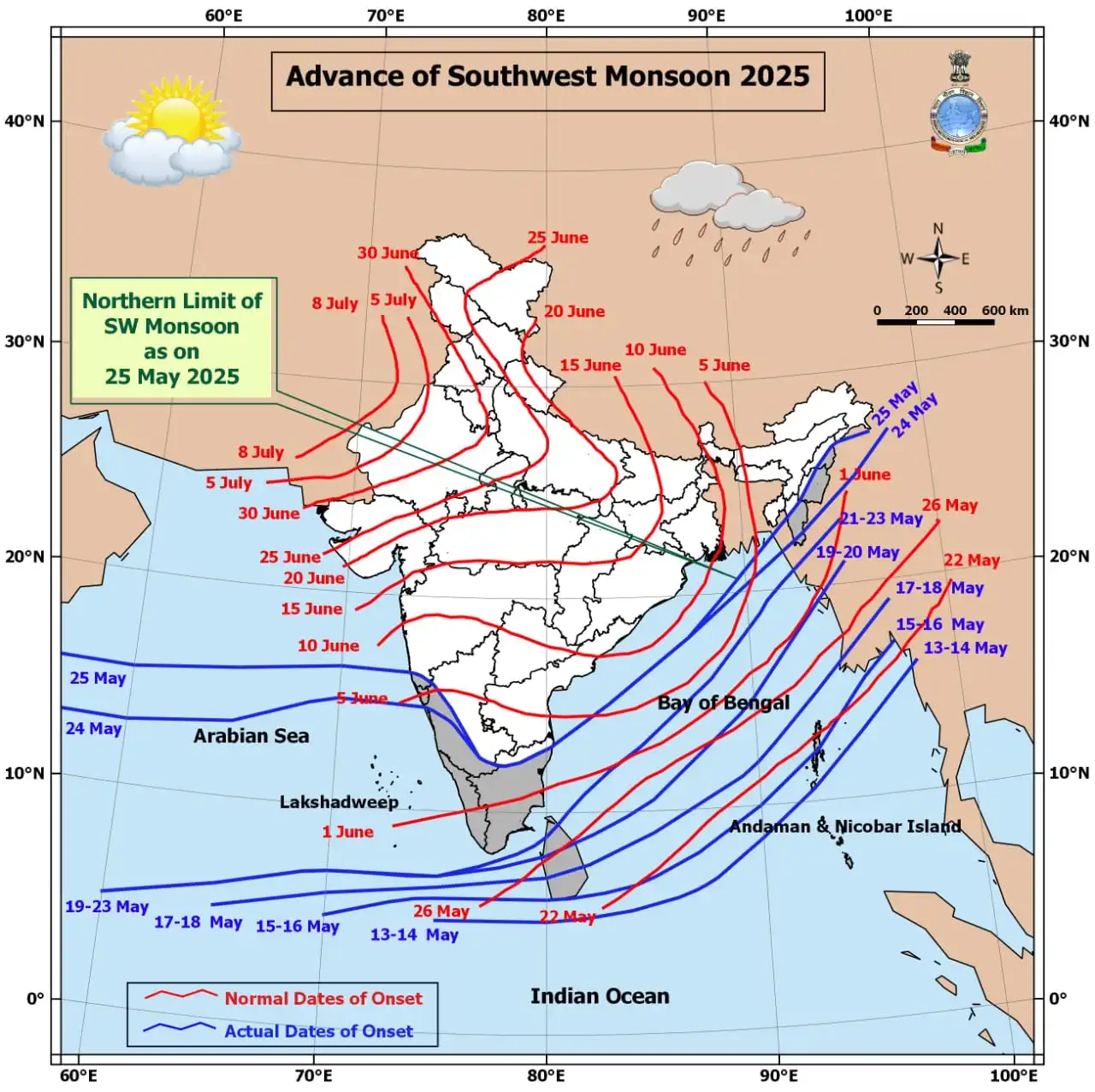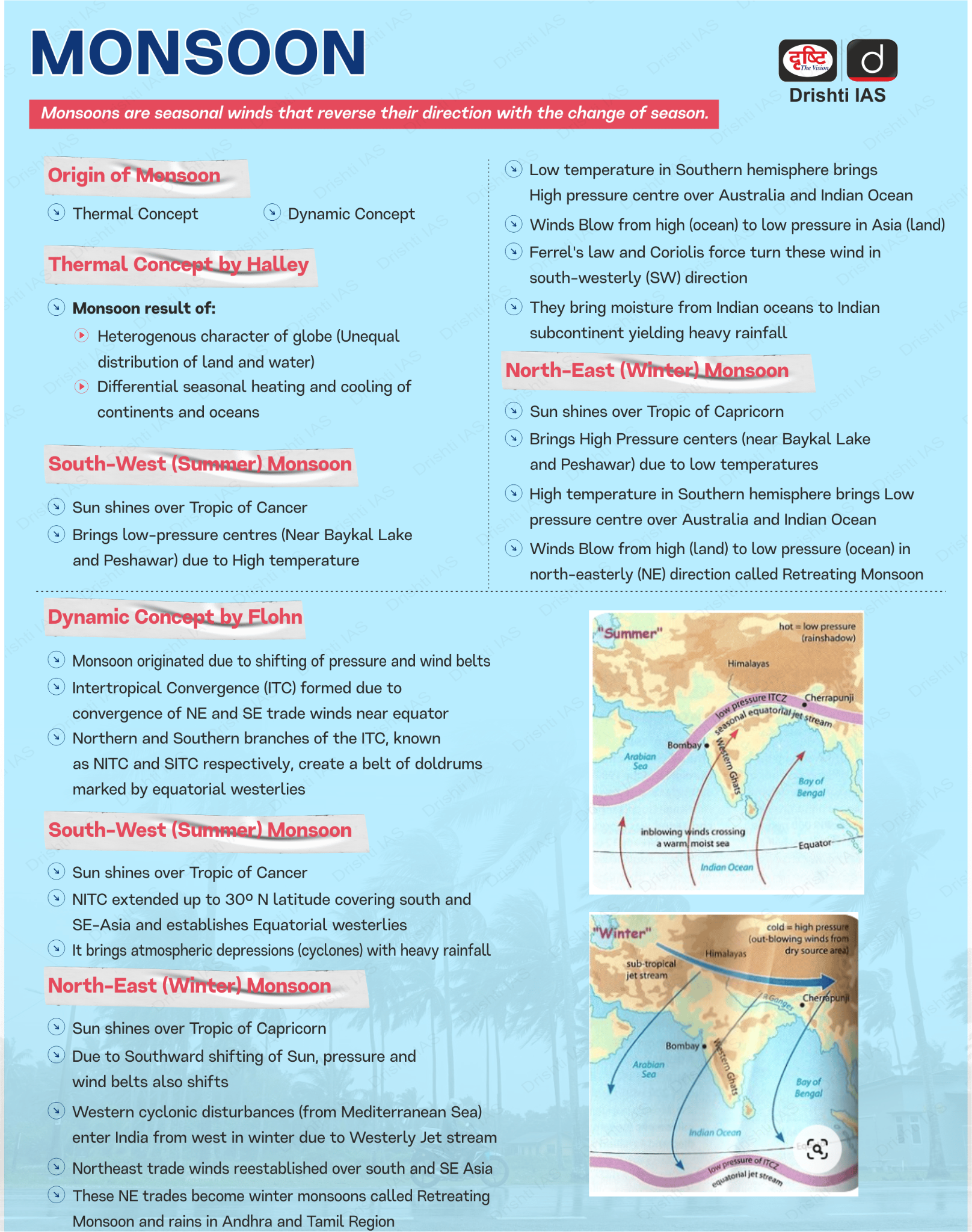Early Monsoon Onset 2025 | 28 May 2025
For Prelims: India Meteorological Department, Southwest monsoon, Westerly winds, Madden-Julian Oscillation, Somali jet
For Mains: Factors influencing the onset of the southwest monsoon over India.
Why in News?
The India Meteorological Department (IMD) declared the southwest monsoon onset over Kerala earlier than usual. This early arrival is significant as the monsoon provides over 70% of India’s annual rainfall, crucial for agriculture and the economy. The last early onset before 2025 was in 2009.
What are the Criteria for Declaring the Onset of the Monsoon?
- Essential criteria: IMD declares monsoon onset anytime after May 10 based on key criteria:
- Rainfall Criteria: After 10th May, if 60% of 14 designated weather stations in Kerala and surrounding areas (e.g., Thiruvananthapuram, Kochi, Mangalore) record ≥2.5 mm rainfall for two consecutive days, onset can be considered on the second day.
- Wind Field: Westerly winds blow from West to East in the 30 to 60 degree latitudes, both in the northern and southern hemispheres.
- For the onset, the depth of westerly winds should be maintained at up to 600 hectoPascals or hPa, which is the unit for measuring atmospheric pressure, and wind speeds must range between 15-20 knots (27-37km/hr) at 925 hPa.
- Outgoing Longwave Radiation (OLR): The INSAT-derived OLR value, which measures the energy emitted to space by the Earth's surface, oceans, and atmosphere, should be below 200 watts per square meter (W/m²) in the region between 5°N and 10°N latitude and 70°E and 75°E longitude, indicating sufficient atmospheric heat conducive to rainfall.
- Once these conditions are met on two consecutive days, IMD declares the monsoon onset.
What Factors Caused the Early Monsoon Onset 2025?
- Madden-Julian Oscillation (MJO): The MJO is a transient eastward-moving system of winds, clouds, and pressure disturbances that travels around the equator.
- It was identified in 1971 by Roland Madden and Paul Julian, scientists at the National Centre for Atmospheric Research in Colorado.
- The MJO typically travels eastward at 4–8 m/s, and completes one global cycle in 30–60 days, though sometimes it takes up to 90 days.
- It influences weather in tropical regions, especially between 30°N and 30°S, which includes India.
- MJO has two distinct phases: an active phase, which brings enhanced convection and increased rainfall, and a suppressed phase, which leads to reduced convection and drier conditions.
- It can trigger cyclones and cause brief but intense rainfall spells, even during dry periods.
- Mascarene High: The IMD describes the Mascarene High as a high-pressure area found around the Mascarene Islands (in the south Indian Ocean) during the monsoon period.
- The variation in the intensity of high pressure is responsible for heavy rains along India’s west coast.
- Convection: An increase in the convective activity, that is, the vertical transport of heat and moisture in the atmosphere, also brings rainfall.
- Somali Jet: It is a low-level, inter-hemispheric cross-equatorial wind band originating near Mauritius and north Madagascar.
- During May, after crossing the east coast of Africa, it reaches the Arabian Sea and the west coast of India. A strong Somali jet is associated with the strengthening of monsoon winds.
- Heat-low: As the Sun moves northward, a low-pressure zone forms over the Arabian Sea and Pakistan, acting like a suction pump to draw moist air along the monsoon trough, boosting monsoon rainfall.
- Monsoon Trough: It is an elongated low-pressure area extending from the heat low to the north Bay of Bengal. The north-south swinging of this trough causes rainfall during the June–September period across the core monsoon zone.
- Cyclonic Monsoon Vortex: It is also known as a Monsoon Onset Vortex (MOV), is a synoptic-scale cyclonic circulation that forms over the Arabian Sea during the Indian summer monsoon.
- These vortices can intensify into tropical cyclones and play a crucial role in the onset and advance of the monsoon.
- Pressure gradients: It is the rate of change of pressure over a given distance. It also supports the strong monsoon onset.
Other Factors Influencing Monsoon
- Monsoon low: It is a type of low-pressure area (LPA) characterized by the lowest pressure at its center with winds blowing anticlockwise in the Northern Hemisphere.
- It causes air to converge and rise, leading to cloud formation and rainfall. During the monsoon season, these LPAs are known as monsoon lows and can intensify into monsoon depressions, which are the main rain-bearing systems of the southwest monsoon over India.
- Tibetan High: It is a warm anticyclone located over the Tibetan Plateau in the middle to upper troposphere during the monsoon season.
- It produces an outflow of easterly winds that form a jet stream near Chennai. The position of this Easterly Jetstream influences the monsoon rainfall pattern over India.
How are Rainfall alerts Categorised?
|
Alert Colour |
Rainfall Category (24 hrs) |
Weather Description |
Advisory / Action |
|
Green |
Less than 64 mm |
Light rain |
No advisory: Weather is generally safe; no action needed. |
|
Yellow |
64.5 – 115.5 mm |
Moderate rain |
Be aware: Minor disruptions possible; stay informed and updated. |
|
Orange |
115.6 – 204.4 mm |
Heavy to very heavy rain |
Be prepared: Likely disruptions in transport, power; take necessary precautions. |
|
Red |
204.5 mm and above |
Extremely heavy rain |
Take action: High risk to life and property; follow emergency measures immediately. |
What is the Impact of Early Onset of Monsoon?
- Boost to Kharif Crop Sowing: Early monsoon facilitates timely sowing of major Kharif crops like rice, maize, millets, toor, and moong, ensuring higher productivity.
- Vegetable and Mushroom Cultivation: Pre-monsoon rains benefit vegetable farmers (e.g., tomatoes, okra, beans) and mushroom growers by creating a cool, moist environment favorable for cultivation.
- Water Resource Management: Early rainfall recharges groundwater, fills reservoirs, and improves irrigation, essential for both agriculture and hydropower generation.
- Increased Spoilage & Inflation Pressure: Unanticipated rains have led to farm-level spoilage, pushing up vegetable prices in cities like Mumbai.
- Weather Extremes and Flood Risks: Heavy downpours, lightning, and gusty winds in parts of Kerala, Karnataka, and Maharashtra raise concerns over localized flooding and damage to standing crops.
- Enhanced Export Potential: Increased crop production could improve farm incomes, boost agri-exports, and support India’s GDP growth.
Why do Cyclones not occur in India during the Peak Monsoon Months?
- Conditions Required for Cyclone Formation: Tropical cyclogenesis (cyclone formation) requires a combination of the following environmental factors:
- Warm ocean waters with temperatures of at least 26.5°C, extending to a depth of 50 meters or more.
- High humidity in the mid-troposphere, around 5 km altitude, to support cloud development.
- Low vertical wind shear, meaning there should be minimal difference in wind speed and direction between the surface and the upper atmosphere, allowing the system to remain vertically aligned.
- A pre-existing low-pressure disturbance near the surface to initiate cyclonic rotation.
- Atmospheric Conditions During Monsoon: Despite warm seas and high moisture (both crucial for cyclone formation) India rarely experiences cyclones during July and August, the peak monsoon months.
- This is primarily due to unfavorable atmospheric conditions, especially strong vertical wind shear that prevents cyclones from developing and sustaining.
- Westerly winds peak at 20–25 knots between 900 and 800 hPa, while easterly winds reach 60–80 knots at 150–100 hPa over peninsular India.
- This results in high vertical wind shear, disrupting cyclone formation and making conditions unfavorable for tropical cyclogenesis during these months.
What is the Impact of Climate Change on Indian Monsoon?
- Increasing Extreme Rainfall Events: Rising trend in both the frequency and magnitude of extreme rainfall events during the monsoon season, particularly over central India. This is attributed to climate change combined with natural variability.
- Alongside more extreme events, there is a decreasing trend in moderate rainfall occurrences during the monsoon season over central India.
- Overall Monsoon Rainfall Decline: Over the last 50 years, summer monsoon precipitation (June to September) over India has declined by approximately 6%, with significant reductions noted over the Indo-Gangetic Plains and the Western Ghats.
- Increase in Heavy Rainfall Frequency: Central India has experienced about a 75% increase in the frequency of daily extreme precipitation events, defined as rainfall exceeding 150 mm per day.
- Warming Atmosphere and Moisture Capacity: The Earth’s rising temperature due to anthropogenic greenhouse gas emissions increases the atmosphere’s capacity to hold moisture.
- According to the Clausius-Clapeyron Relation principle, the moisture-holding capacity of air increases by approximately 7% for every 1°C rise in temperature.
- As the atmosphere holds more moisture, heavy rainfall events are expected to become more frequent and intense under changing climate conditions.
Withdrawal of Monsoon
- The withdrawal of monsoon is defined as the gradual retreat of the southwest (SW) monsoon from different parts of India. It marks the end of the rainy season and is characterized by:
- Cessation of rainfall for at least 5 consecutive days.
- Change in wind patterns, especially a shift from southwesterly to northeasterly directions.
- Reduction in atmospheric moisture as seen in satellite water vapour imagery and tephigrams.
- Formation of anticyclonic circulation in the lower troposphere (850 hPa and below).
|
Drishti Mains Question: Discuss the atmospheric and oceanic factors responsible for the early onset of the southwest monsoon. |
UPSC Civil Services Examination, Previous Year Question (PYQ)
Prelims:
Q. With reference to ‘Indian Ocean Dipole (IOD)’ sometimes mentioned in the news while forecasting Indian monsoon, which of the following statements is/are correct? (2017)
- The IOD phenomenon is characterized by a difference in sea surface temperature between tropical Western Indian Ocean and tropical Eastern Pacific Ocean.
- An IOD phenomenon can influence an El Nino’s impact on the monsoon.
Select the correct answer using the code given below:
(a) 1 only
(b) 2 only
(c) Both 1 and 2
(d) Neither 1 nor 2
Ans: (b)
Mains:
Q. How far do you agree that the behavior of the Indian monsoon has been changing due to humanizing landscape? Discuss. (2015)


